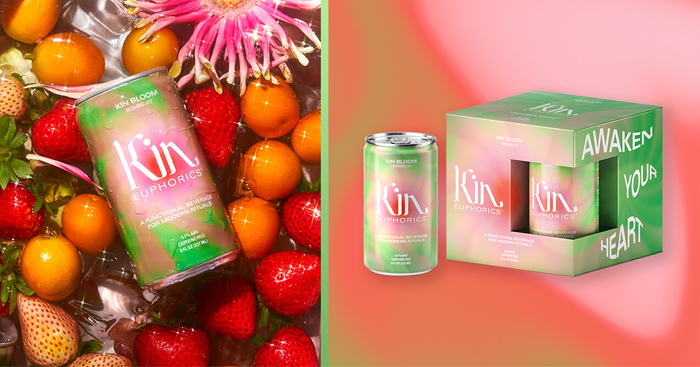
When Kin Euphorics debuted in 2018, the idea of a nootropic-infused, cognition-enhancing, non-alcoholic aperitif wasn’t necessarily top of mind for consumers or retailers, according to co-founder and CEO Jen Batchelor.
Four years later, the New York City–based brand is now riding a wave, spurred by the pandemic, that’s driving consumers and sales toward the non-alc set. Looking to its next stage of ‘evolution,’ Kin has introduced the first extension of its spritz line, Kin Bloom, and is readying a deeper push into retail with a trio of experienced new hires hailing from mixer brand Fever Tree.
“Everyone spent the first two months of the pandemic hoarding alcohol and partying like it was the end of the world,” Batchelor said while describing an uptick in Kin sales during the early pandemic months. “[And we thought] either everyone was really hungover and curing it with a Kin Spritz or something else was brewing.”
Around that time, Kin began brewing up Bloom, and after 18-months of innovation, the rosé-inspired, zero sugar and caffeine-free beverage rolled out this month with functional ingredients like schisandra, damiana, L-theanine and ashwagandha. The launch also marks a new commitment by the brand to source domestic ingredients grown with ‘biodynamic regenerative’ practices, and, if that isn’t possible, to establish the capacity to self-cultivate the ingredient for the next decade.
That promise was made with consumers’ interests and Kin’s plan for long-term sustainable growth in mind, which includes a ‘tactful’ retail expansion with the help of new hires Chris Burleson as CCO, Lisa Gulick as VP of Sales and Ashley Costa as Director of National Accounts, Retail. The trio each bring a decade of CPG experience to their respective roles and aim to accelerate awareness of Kin and widen the product’s availability.
“Not only has [the non-alc set] been advancing [with consumer interest], I’ve seen increased interest in the space from our retail partners and from our distribution partners,” said Burleson. “It went from virtually nonexistent or at least non-important to something which, I believe in the future, retailers will look to create a section of the shopping experience to house.”

While seeking to make itself more accessible, Kin does not intend to back away from its premium positioning, with Burleson noting its price point ($30 per 4-pack) has actually proved to be attractive to retailers due to the current economics of shipping heavy products like RTD liquids. According to Burleson, on shelf placement executed in a “tactful and mutually beneficial manner,” although the company is also looking to national retail partnerships where it can “lean into programs that will amplify [the retailer’s] basket ring.”
Kin is currently available in about 1,000 stores nationwide including LA-based grocer Erewhon, and aims to establish a mix of on-premise, retail (including mass and liquor) and online distribution.
This retail push has also opened up a new world of insights for the brand, said Batchelor, which previously gathered consumer feedback via its own first party platform and voluntary online testimonials. She said bringing retail data into the mix will strengthen its innovation process as it looks to build a portfolio that makes Kin the “Spotify of beverage.” The goal is for a consumer to be able to “tell us how you feel or what you want this for” and for Kin to be able to respond with a product that caters to both the activity and intended attitude.
Batchelor said she has taken this “Socratic approach” in all aspects of building the Kin brand, explaining that it also surveyed consumers on why they use alcohol and, in the over 7,000 responses, Kin’s team found that most consumers “use alcohol functionally.” She said Kin aims to recreate the nuanced uses and functions consumers seek through alcohol with “functions that actually make you feel good.”
Looking long term, Bachelor explained that Kin was “designed to be evolved” with consumer insight and flexibility as its foundation describing that when the brand launched, “it was a time for the community that was choosing this lifestyle to help us evolve, help us really refine it.”She doesn’t believe Kin’s growth will be held back despite its niche functions and flavors and said now that the brand and its core audience have been established, its roadmap for the next ten years will continue to be driven by consumer interests, supported by the success it has seen thus far.
“Looking at the data we are seeing [at the retail level], Kin is punching well above its weight and delivering – we are outperforming some of the best functionals out there,” Batchelor said. “I’ve never seen Kin as a competitive brand, we were just our weird selves in the corner with our freak flag up and just being okay growing at the pace that we were, but now it’s really exciting to see that consumers are looking for intuitive solutions for energy, immunity or just to wind down.”